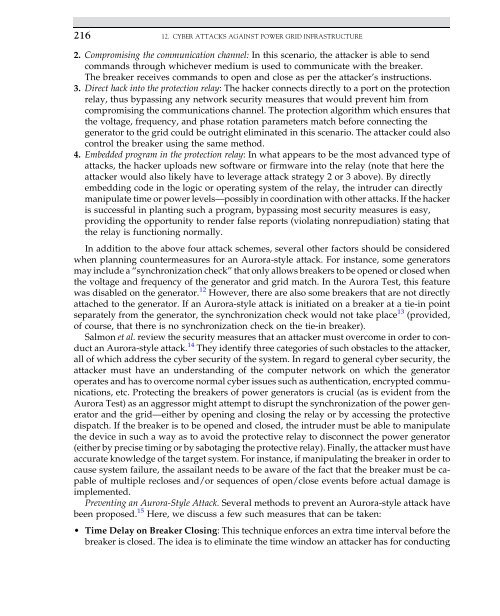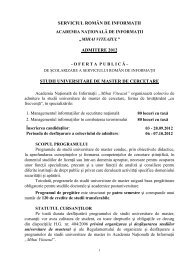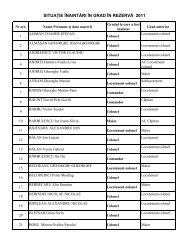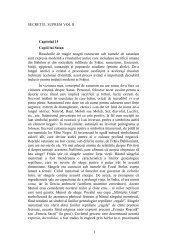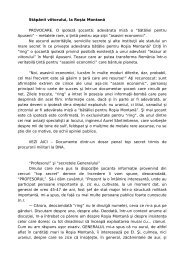Introduction to Cyber-Warfare - Proiect SEMPER FIDELIS
Introduction to Cyber-Warfare - Proiect SEMPER FIDELIS
Introduction to Cyber-Warfare - Proiect SEMPER FIDELIS
Create successful ePaper yourself
Turn your PDF publications into a flip-book with our unique Google optimized e-Paper software.
216 12. CYBER ATTACKS AGAINST POWER GRID INFRASTRUCTURE2. Compromising the communication channel: In this scenario, the attacker is able <strong>to</strong> sendcommands through whichever medium is used <strong>to</strong> communicate with the breaker.The breaker receives commands <strong>to</strong> open and close as per the attacker’s instructions.3. Direct hack in<strong>to</strong> the protection relay: The hacker connects directly <strong>to</strong> a port on the protectionrelay, thus bypassing any network security measures that would prevent him fromcompromising the communications channel. The protection algorithm which ensures thatthe voltage, frequency, and phase rotation parameters match before connecting thegenera<strong>to</strong>r <strong>to</strong> the grid could be outright eliminated in this scenario. The attacker could alsocontrol the breaker using the same method.4. Embedded program in the protection relay: In what appears <strong>to</strong> be the most advanced type ofattacks, the hacker uploads new software or firmware in<strong>to</strong> the relay (note that here theattacker would also likely have <strong>to</strong> leverage attack strategy 2 or 3 above). By directlyembedding code in the logic or operating system of the relay, the intruder can directlymanipulate time or power levels—possibly in coordination with other attacks. If the hackeris successful in planting such a program, bypassing most security measures is easy,providing the opportunity <strong>to</strong> render false reports (violating nonrepudiation) stating thatthe relay is functioning normally.In addition <strong>to</strong> the above four attack schemes, several other fac<strong>to</strong>rs should be consideredwhen planning countermeasures for an Aurora-style attack. For instance, some genera<strong>to</strong>rsmay include a “synchronization check” that only allows breakers <strong>to</strong> be opened or closed whenthe voltage and frequency of the genera<strong>to</strong>r and grid match. In the Aurora Test, this featurewas disabled on the genera<strong>to</strong>r. 12 However, there are also some breakers that are not directlyattached <strong>to</strong> the genera<strong>to</strong>r. If an Aurora-style attack is initiated on a breaker at a tie-in pointseparately from the genera<strong>to</strong>r, the synchronization check would not take place 13 (provided,of course, that there is no synchronization check on the tie-in breaker).Salmon et al. review the security measures that an attacker must overcome in order <strong>to</strong> conductan Aurora-style attack. 14 They identify three categories of such obstacles <strong>to</strong> the attacker,all of which address the cyber security of the system. In regard <strong>to</strong> general cyber security, theattacker must have an understanding of the computer network on which the genera<strong>to</strong>roperates and has <strong>to</strong> overcome normal cyber issues such as authentication, encrypted communications,etc. Protecting the breakers of power genera<strong>to</strong>rs is crucial (as is evident from theAurora Test) as an aggressor might attempt <strong>to</strong> disrupt the synchronization of the power genera<strong>to</strong>rand the grid—either by opening and closing the relay or by accessing the protectivedispatch. If the breaker is <strong>to</strong> be opened and closed, the intruder must be able <strong>to</strong> manipulatethe device in such a way as <strong>to</strong> avoid the protective relay <strong>to</strong> disconnect the power genera<strong>to</strong>r(either by precise timing or by sabotaging the protective relay). Finally, the attacker must haveaccurate knowledge of the target system. For instance, if manipulating the breaker in order <strong>to</strong>cause system failure, the assailant needs <strong>to</strong> be aware of the fact that the breaker must be capableof multiple recloses and/or sequences of open/close events before actual damage isimplemented.Preventing an Aurora-Style Attack. Several methods <strong>to</strong> prevent an Aurora-style attack havebeen proposed. 15 Here, we discuss a few such measures that can be taken:• Time Delay on Breaker Closing: This technique enforces an extra time interval before thebreaker is closed. The idea is <strong>to</strong> eliminate the time window an attacker has for conducting


